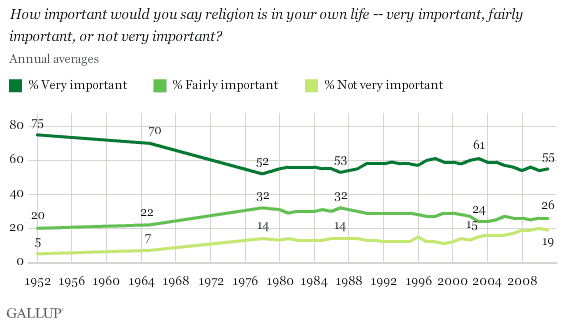PRINCETON, NJ -- This Christmas season, 78% of American adults identify with some form of Christian religion. Less than 2% are Jewish, less than 1% are Muslim, and 15% do not have a religious identity. This means that 95% of all Americans who have a religious identity are Christians.

These results are based on a compilation of 327,244 interviews conducted as part of Gallup Daily tracking from January-November 2011. The detailed breakdown shows that about a third of American Christians are Catholics, while two-thirds identify as Protestants or some other non-Catholic Christian religion. All in all, 82.5% of Americans have some form of religious identity.
Gallup's methods of measuring religious identity have changed over the decades, but one major trend that is clear from Gallup's and other organizations' surveys is the increase in the percentage of Americans who do not have a formal religious identity. Some 60 years ago, in 1951, for example, just 1% of Americans in Gallup surveys said they didn't have a religious identity. At that time, Gallup classified 68% of Americans as identifying with a non-Catholic Christian faith, and 24% who were Catholic.
Separate Gallup questioning earlier this year shows that 92% of Americans say they believe in God. This suggests that the lack of a religious identity is not in and of itself a sign of the total absence of religiosity.
Additionally, in two separate surveys conducted in May and in late November/early December of this year, an average of 55% of Americans said religion is very important in their lives, another 26% said it is fairly important, and 19% said it is not very important.

Americans' self-reported importance of religion has remained broadly stable over the past three or four decades, with a slight increase in the percentage saying religion is not very important, and a slight decrease in the percentage saying it is fairly important. Surveys conducted in the 1950s and 1960s showed a higher percentage saying religion was very important.
Bottom Line
The United States remains a predominantly Christian nation, with 78% of all adults identifying with a Christian faith, and more than 9 in 10 of those who have a religious identity identifying as Christians. Fifteen percent of Americans do not have a formal religious identity, a continuation of a dramatic change from 50 and 60 years ago, when almost all Americans identified with a particular religion. The precise implications of the increase in the "no religious identity" segment are not clear, given that more than 9 in 10 Americans say they believe in God, and that 8 in 10 say religion is a very or fairly important part of their lives.
Survey Methods
Results are based on telephone interviews conducted as part of the Gallup Daily tracking survey Jan. 2-Nov. 30, 2011, with a random sample of 327,244 adults, aged 18 and older, living in all 50 U.S. states and the District of Columbia.
For results based on the total sample of national adults, one can say with 95% confidence that the maximum margin of sampling error is ±1 percentage point.
Interviews are conducted with respondents on landline telephones and cellular phones, with interviews conducted in Spanish for respondents who are primarily Spanish-speaking. Each sample includes a minimum quota of 400 cell phone respondents and 600 landline respondents per 1,000 national adults, with additional minimum quotas among landline respondents by region. Landline telephone numbers are chosen at random among listed telephone numbers. Cell phone numbers are selected using random-digit-dial methods. Landline respondents are chosen at random within each household on the basis of which member had the most recent birthday.
Samples are weighted by gender, age, race, Hispanic ethnicity, education, region, adults in the household, and phone status (cell phone only/landline only/both, cell phone mostly, and having an unlisted landline number). Demographic weighting targets are based on the March 2010 Current Population Survey figures for the aged 18 and older non-institutionalized population living in U.S. telephone households. All reported margins of sampling error include the computed design effects for weighting and sample design.
In addition to sampling error, question wording and practical difficulties in conducting surveys can introduce error or bias into the findings of public opinion polls.
For more details on Gallup's polling methodology, visit www.gallup.com.
